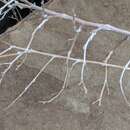Description
provided by eFloras
Perennial, much branched, woody shrub. Young branches covered with greyish pubescence, spiny at apices. Leaves fasciculate, alternate on new shoots, sessile, oblanceolate-spathulate or oblong-spathulate, attenuate, up to 50 mm long, 3-8 mm broad, apex obtuse, mucronulate, sparsely hairy; stipules minute, mem¬branous. Flowers sessile, c. 4 mm across, whitish-yellow. Sepals slightly connate at the base, broadly ovate, 1.5-2 mm long, glabrous or glabrescent. Petals concave, 2.5-3.5 mm long, glabrous, hooded at the apex. Stamens in 3 whorls of 5 each. equal, outer whorl opposite the sepals, middle and inner whorls anti petalous, anthers oblong, versatile, those of middle and inner whorls enclosed by apical hood of petals. Drupe 5-15 mm in diameter, ovoid-spherical, longitudinally sulcate, reddish-purple, glabrous.
- license
- cc-by-nc-sa-3.0
- copyright
- Missouri Botanical Garden, 4344 Shaw Boulevard, St. Louis, MO, 63110 USA
Distribution
provided by eFloras
Distribution: S.E. Romania, South Russia, Chinese Turkestan, Siberia, Syria, Palestine, Turkey, Iran and Pakistan.
- license
- cc-by-nc-sa-3.0
- copyright
- Missouri Botanical Garden, 4344 Shaw Boulevard, St. Louis, MO, 63110 USA
Nitraria schoberi: Brief Summary
provided by wikipedia EN
Nitraria schoberi, the nitrebush (a name it shares with other members of its genus), is a species of flowering plant in the family Nitrariaceae. It has an Irano-Turanian distribution. Its fruit, edible and salty-sweet, are collected by local peoples and eaten fresh or preserved. Archeological evidence shows that people have been eating the fruit since Epipalaeolithic times.
- license
- cc-by-sa-3.0
- copyright
- Wikipedia authors and editors

